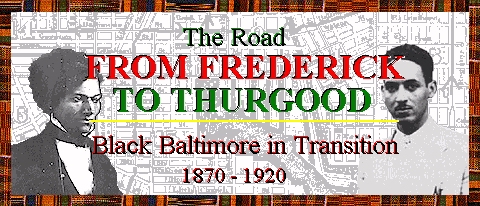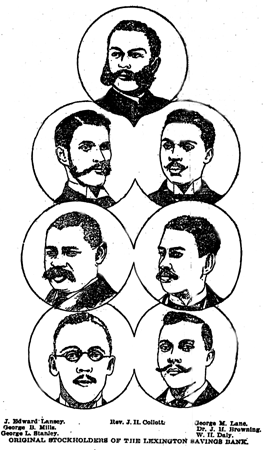 |
The Lexington Savings Bank |
 |
The Lexington Savings Bank |
 |
On June 1, 1896, the first annual meeting of the Lexington Savings Bank's stockholders was "largely attended and was very enthusiastic." The motivating force behind the bank's formation was Waring himself. While in Washington D. C. attending Howard University Law School in the early 1880s, Waring followed the progress of the Capital Savings Bank, an institution managed by African Americans. He was impressed by the bank's success and, after moving to Baltimore, he investigated the possibility of opening a similar institution in that city. Leaders of the African American community agreed with Waring that such an institution would "aid in the prosperity of his people," and on May 1, 1895, he held a meeting of potential stockholders. At this meeting, citizens purchased $3,500 of stock, and selected the bank's officers, choosing Waring as the bank's president. Nine days later, the bank was incorporated with a capital stock of $10,000 and opened for business on May 15, 1895. [1] | |

|
From its inception, scores of prominent African Americans involved themselves in the Lexington Savings Bank. Besides Waring, four men signed the bank's charter; all of them were well-respected in the community. The Baltimore Morning Herald claimed that "the other directors and stockholders are men of reputation and have many friends, both among colored and white citizens." George B. Mills and George M. Lane were original stockholders of the bank. Mills was vice-president of the bank, ran for the City Council from the 11th Ward, and headed the Order of Esdras. Lane was a well-known lawyer and served as the bank's attorney. George L. Stanley had been an Inspector of Customs and served as the bank's bookkeeper. The Reverend J. H. Collett was extremely influential in the Baltimore A. M. E. Church. W. H. Daly was a butcher and president of the North Western Family Supply Company, a business owned and run by African Americans. Julius C. Johnson was a caterer at Ganzborn's Hotel, while Henry R. Hooker ran a furniture business and participated in the Nazarite and Masonic Orders. J. Edward Lansey was a messenger to the Postmaster, and Dr. J. W. Browning was a prominent druggist. [2] | |
|
When the bank opened, Waring stated that "There are 80,000 colored population in this city, who have between $2,000,000 and $3,000,000 invested in the savings concerns of Baltimore. If we can get a small portion of this investment diverted to our hands success is ours. The outlook is extremely flattering." To help ensure the success of his fledgling venture, Waring temporarily abandoned his legal practice and gave the bank his almost undivided attention. [3] The Morning Herald reported that the bank "was the only one of its kind in Baltimore. It was supported entirely by colored people . . . [and] the institution catered entirely to the poorer classes." Its depositors were mostly "laboring people," many of them elderly pensioners, who had small amounts of money in the bank. By 1896, the bank had several hundred depositors. The Sharp Street Church of Bengles had "its entire missionary and building fund" in the bank; clearly, the African American community had great hope for and faith in the bank's future prospects. The bank's performance in 1895 and 1896 proved the community's confidence to be well-founded. The Afro-American devoted nearly the entire first page of the June 13, 1896 issue to a celebration of the bank's successful first year. Less than one year later, however, a major scandal erupted that would touch everyone involved with the bank, and ultimately ruin Everett Waring's reputation and career in Baltimore. [4] | ||
![]() Returnto Business & Industry Introduction
Returnto Business & Industry Introduction
![]() Returnto The Road From Frederick To Thurgood Introduction
Returnto The Road From Frederick To Thurgood Introduction
|
Tell Us What You Think About the Maryland State Archives Website!
|
© Copyright December 02, 1998 Maryland State Archives